![]()
![]()
![]()
Use LEFT and RIGHT arrow keys to navigate between flashcards;
Use UP and DOWN arrow keys to flip the card;
H to show hint;
A reads text to speech;
48 Cards in this Set
- Front
- Back
|
What does a macrophage do to a bacteria?
|
Macrophages move to engulf bacteria.
|
|
|
What is immunity?
|
IMMUNITY
The ability to resist infection. |
|
|
What is infection?
|
INFECTION
Where the microbe colonizes, evades defenses and grows faster than host response. |
|
|
What are the two types of immunity?
|
1. Non Specific (innate) Immunity
First & Second Line of Defense 2. Specific (Adaptive) Immunity 3rd Line of Defense |
|
|
In Non- Specific (innate) Immunity, what composes the 1st line of defense?
|
In Non- Specific (innate) Immunity, 1st line of defense
a) intact skin b) Mucous membranes and their secretions c) Normal Microbiota |
|
|
In Non- Specific (innate) Immunity, what composes the 2nd line of defense?
|
In Non- Specific (innate) Immunity, 2nd line of defense
a) Phagocytic white blood cells b) Inflammation c) Fever d) Antimicrobial sunstances |
|
|
In Specific (adaptive) Immunity, what composes the 3rd line of defense?
|
Specific (adaptive) Immunity; the 3rd line of defense.
a) Specialized Lymphocytes B and T cells b) Antibodies |
|
|
What are some physical (anatomical) barriers for non specific 1st line of defense?
|
physical (anatomical) barriers
a) removal of inhaled particles through breathing and coughin b) Skin- physical barrier c) Mucus and cilia which is glycoprotein based that lines the esophagus and other entryways to trap and move foreign microbes. c) Flushing of the urinary tract so it does not create backflow to GI tract and releases waste. |
|
|
What are some chemical barriers for non specific 1st line of defense?
|
chemical barriers prevent growth for non specific 1st line of defense
a) Anti microbial factors in saliva (lysozyme, perioxidase, lactoferrin) b) Lysozyme (breaks down peptidoglycne) in secretions and phagocytes. c)Barrier like fatty acids, sweats with low PH (High salinity or salt content) and are acidic. Cebum Fatty acids in our hair makes our skin oily but has acidic low PH. c) Acid in stomach d) Rapid Ph changes from stomach to intestines. |
|
|
What are some Normal Microbiota for non specific 1st line of defense?
|
Normal Microbiota for non specific 1st line of defense using 3 types of Symbioses
a) Commensals (bacteria benefits but not the other) and is neither good or bad b) Beneficial c) protection by other microbes since they attack other foreign microbes or inhibit other type of species growth |
|
|
Summarize Physical & Chemical Barriers to Infection; Intact Skin.
|
Physical & Chemical Barriers to Infection; Intact Skin
* Water-repellent - keratin in outermost layer * Continual shedding of dead cells * Thick, fibrous dermis Low pH (3-5) of fungistatic fatty acid in sebum secreted onto skin * High salinity - salt residue from perspiration |
|
|
Summarize Physical & Chemical Barriers to Infection; Mucous Membrane.
|
Physical & Chemical Barriers to Infection; Mucous Membrane
* Bathed with sticky mucus Ciliary escalator * Flushing & peristalsis Lysozyme in perspiration, tears, saliva, and tissue fluids Low pH (1.2-3.0) of gastric juice * Transferrins in blood bind iron |
|
|
T or F
A breach in the anatomical barriers can leave the host open to infection |
True
|
|
|
Summarize the protective effect of normal microbiota.
|
protective effect of normal microbiota
Normal microbiota protect the host by successful microbial antagonism (competitive exclusion): 1) adhering to binding sites on host cells preventing attachment by pathogens 2) making the environment less hospitable to potential pathogens by altering the pH (secreting acids) 3) producing bacteriocins (antimicrobials) 4) stimulating host’s immune system |
|
|
True or False
T or F Disruption of the microbial balance does not leave host vulnerable to overgrowth by opportunistic pathogens |
FALSE
Disruption of the microbial balance leaves host vulnerable to overgrowth by opportunistic pathogens |
|
|
What is microbiota?
|
Fancy word for microorganisms
|
|
|
What can microbial antagonism do?
|
Microbial Antagonism can secreted acids and make antibodies and they compete with each other for survival.
|
|
|
What is competitive exclusion.
|
Microbes that are very specific on preferences in order to attack or maintain an optimum environment.
|
|
|
How do pathogens and bacteria enter the body for babies?
|
When the imbryotic fluid is broken a baby is exposed to the mothers diseases and other microbes. It is usually during birth and or in the birth canal that microbes are picked up.
|
|
|
Where is the Thymus located and why is it not present in adults?
|
Thymus-
Located above the heart and is found only in young children which is centralized to create lymphocytes to combat infection. In adults, creation of lymphocytes occur in red marrow (spongy area inside bone). |
|
|
What is the lymphatic system and its purpose?
|
Lymphatic system is like the bodies network of creating, housing and transporting lymphocytes (white blood cells) in order to combat infection.
|
|
|
What does it mean when the lymphatic system is decentralized?
|
Lymphatic system is decentralized because many different organs are in different places in the body.
Anatomically decentralized: 1. Primary lymphoid organs Bone marrow Thymus 2. Secondary lymphoid organs Lymph nodes Spleen 3. Lymphatic vessels |
|
|
When a person has enlarged lymph nodes, what is happening?
|
Bacteria accumulation response means more lymphocytes are being made in the lymph nodes where they are collected and are found in the cervical (near head), hip, and axillary (legs).
|
|
|
T or F
The bone marrow creates hematopoetic stem cells that can specialize into all kinds of different cells including leukocytes (white blood cells) |
True
|
|
|
What are the 3 different types of stem cells?
|
1) Hematopoetic stem cells created in bone marrow that can form into
2) Stem Cells for all except lymphocytes 3) Lymphoid Stem Cells |
|
|
What is the most common type of cell?
|
Blood Cells
|
|
|
What is the root word "THROMBO" mean?
|
THROMBO = CLOT
means clot thus thrombocytes help clot blood |
|
|
What do red blood cell carry?
|
Oxygen
|
|
|
What are megakaryocytes and what do they produce?
|
Megakaryocytes are one type of specialized cell that is made by stem cells that remains in the bone marrow and are very big and produce platelets or thrombocytes in order to help clot blood.
|
|
|
What are the 3 granulocytes?
|
Granulocytes
1) Eosinophils (red= eosin) 2) Basophils (blue = baso) 3) Nuetrophils (pink) *all the granulocytes end in phils and are distinguished by the granules in the cytoplasm of the cell and multi lobed nucleus. |
|
|
What are the 3 other Leukocytes (white blood cells) other than the granulocytes?
|
1) Monocytes that turn into
a) Macrophages that stays in tissues. b) Dendritic Cells (not found in blood) 2) T lymphocytes process in thymus. T for Thymus 3) B lymphocytes process in bone marrow. B for Bone marrow. (found in plasma cells) *lymphocytes stain blue |
|
|
What are macrophages and dendritic cells that are derived from monocytes also called?
|
Mononuclear phagocytes (one nucleas foreign eaters by engulfing)
|
|
|
What is leukocytosis?
|
increase in Leukocytes (white blood cells)
|
|
|
What is Leukopenia?
|
decrease in Leukocytes (white blood cells)
|
|
|
T or F
Leukocytosis and Leukopenia are some indicators for leukemia. |
True
|
|
|
T or F
non specific immune cells like luekocytes (white blood cells) are generalized and not specific and have slow response. |
False
non specific immune cells like luekocytes (white blood cells) are generalized and not specific and have QUICK response. |
|
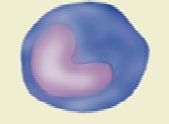
What am I?
|
Monocytes (circulates; ~ 3 – 8% of WBC’s)
* Precursor cell to macrophages and dendritic cells * Circulate in bloodstream until needed in tissues * Differentiate in the tissues into macrophages |
|
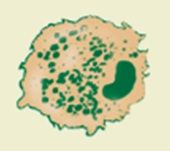
What am I?
|
Macrophages (in tissues)
* Professional phagocytes; inflammation * Recruit more phagocytes for rapid removal of invader * Can be “activated” to increase killing power * Always present as a “sentry” in certain tissues |
|
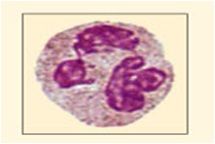
What am I?
|
Neutrophils (circulates; ~ 60 - 70% of WBC’s)
* Rapid responder * Recruited to tissues during inflammation * Granules: highly phagocytic; effective against bacteria * Short-lived |
|
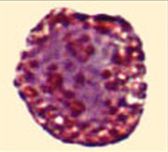
What am I?
|
Basophils (circulates; ~ 0.5 - 1% of WBC’s)
* Inflammation; allergic response * Granules: produce histamine; vasodilator * Mast cells perform same role in tissues (Bases require fire thus inflammation and masts are bases thus mast cells) |
|
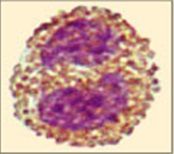
|
Eosinophils (circulates; ~ 2 - 4% of WBC’s)
* Allergic response; toxic to parasites * Granules: triggered to release degradation enzymes * Somewhat phagocytic (sounds like easy no = toxic allergic red) |
|
|
Summarize Cytokines.
|
Cytokines – Chemical Communication
1) Surface receptors – detect chemical components of microbes 2) Communicate findings by release of cytokines - protein messengers 3) Cytokines picked up by other immune cells 4) Triggers response to original stimulus |
|
|
Summarize Chemokines.
|
Chemokines - chemical attractants inducing chemotaxis.
|
|
|
What are the complement systems 3 protective outcomes?
|
1) Opsonization (sounds like option as friend or foe thus flags enemies)
2) Inflammation (Gathers troops or phagocytes by allowing to enter through blood vessels) 3) MAC (membrane Attack Complex) |
|
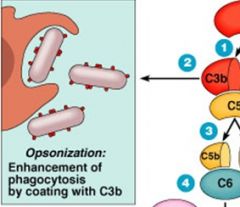
|
Opsonization (protein)
Flags foreign material and microbes by attachement of Complement Cell C3b for destruction by phagocytes. |
|
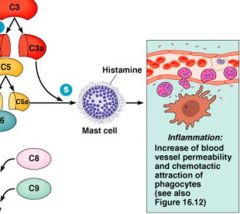
|
Inflammation- mast cells surrounded by histamine which is a chemical dialator that enlarges the diameter of the blood vessels allowing recruitment and collection of immune cells. The 1st responders are neutrophils.
Degranulation is the release of histamines. |
|
|
What is degranulation?
|
Degranulation is the release of histamines.
|
|

|
Membrane Attack Complex (MAC) that creates several donut like holes in pathogen though use of complement cells c5-c9 which helps to destabalize pathogens. Most effective again gram negative bacteria because it tears through inner and outer membrane.
|

